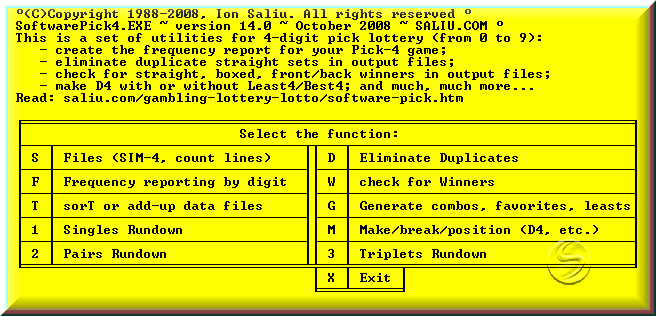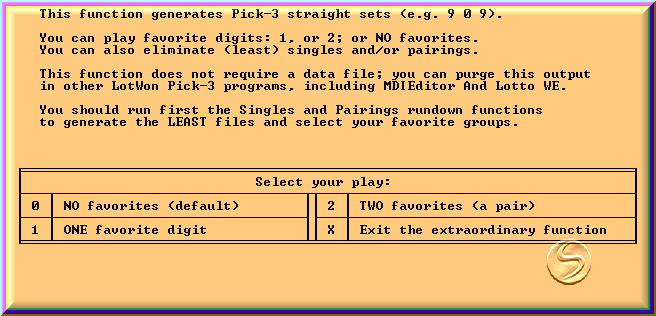
Special lottery utility software for the 3- and 4-digit pick lotteries
By Ion Saliu, ★ Founder of Pick Lottery Mathematics



• SoftwarePick3:
• SoftwarePick4:
~ Special lottery utility software for the 3- and 4-digit lottery games.
Last update: ~ Version 15.0 ~ April 2009; lifted all restrictions on generating straight pick sets (including eliminating the least pairings and triples). The two powerful packages will be also integrated in the Bright packages that will run under 64-bit Windows Vista.
Software category: 5.1.
The two programs are special upgrades to the lottery software tools known as Util-332 and Util432. Many players have used the two packages for several years now.
The digit lotto games are very well known, especially in the United States. The pick lotteries are also known as digit lotteries, as the lottery commissions draw at least one game every day. Most commissions conduct now two drawings a day: Mid-day and evening.
Pick-3 draws three digits from 0 to 9 for a total of 1000 straight sets. The top prize is US $500. This is the quickest way to cash the double amount of a quarter of a thousand US dollar$. I know the case of a former farm worker fellow who won $1000 in early 1980's. It was a snowy day and the farm hands quit the work early. The guy said he was going to play $2 in the pick3 lottery. He played a number that did not represent the date, or his birthday. He said he played one pick-3 number that stuck in his mind for some time — and the number had not been drawn in recent memory.
Pick-4 draws three digits from 0 to 9 for a total of 1O000 straight sets. The top prize is US $5000.
For the bulk of the functions, I will refer you back to the material that presents the entire collection of lottery and lotto utility software:
I will analyze here mainly the new functions: the Rundown functions and the Combination generating modules. First, let's take a peek at the main menus.


Programming pick lottery software is more difficult than programming lotto games, in some regards. Daily lottery is a form of exponential sets (Ion Saliu sets). The lotto games consist of combinations, a sub-set of exponents. The exponential sets can have duplicate elements (digits). The position of each element is also of the essence. The lotto combinations consist of only unique elements (numbers); the position of the elements in the combination is not of the essence. Fortunately, the huge library of my previous programming helped a lot. Still, I needed mathematical discoveries to carry out the goal of writing the new modules of this type of software.
No wonder there is NO other comparable software for digit lotteries. It appears that I am the only one who is able and apt to write software for the Ion Saliu sets.

• The Rundown functions perform statistical analyses of single and multiple digit groups in the pick 3/4 lottery games. The groups are:
~ singles: one digit at a time, of course!
~ pairings: 2-digit groups;
~ triplets: 3-digit groups (for pick4 only).
You already saw the statistical reports for the triplets and the quadruplets in the total freeware (the ToolsLotto software). You also saw a closer lottery game: Quinto. The programs determine the span of analysis or parpaluck for each number group. The span of analysis is calculated by the Fundamental Formula of Gambling (FFG). It represents N (number of past lottery drawings) for a degree of certainty DC = 50%.
As I said, I came across mathematical discoveries. The most important flashes of creativity were related to the Fundamental Formula of Gambling (FFG) and its fundamental elements: Probability (p), degree of certainty (DC), and number of trials (N). The number of trials N had given me some problems in establishing the range of analysis for the lottery wonder grid. I had tried lots of ranges, or number of past drawings to analyze. In order to simplify, I introduced the concept of parpaluck. It is simpler to say or write than number of past drawings to analyze!
Programming SoftwarePick helped me determine precisely the parpalucks for any probability, degree of certainty and number of trials. If the degree of certainty is 50% (the FFG median), then the parpaluck must output half of the elements, while half of the elements are still idle. SoftwarePick 3/4 does exactly that for single digit groups, pairs (pairings), or triplets (applicable to the straight elements).
The singles, pairs (pairings), triples are the primordial lottery filters. Other filters, such as Ion1 to Ion5, Bun, Ver, Any, Pairs, Syn, Deltas, etc. are derived filters. The primordial filters are immediately derived from FFG. The derived filters, which have a minimum and a maximum level, necessitate a second step of applying the Fundamental Formula of Gambling.
I believe I perfected the calculations for probability p, FFG median (degree of certainty DC = 50%), and range of analysis (number of past drawings N to analyze). The best way is to generate first all straight sets in the game (all possibilities or all possible cases). Then, count the occurrence of every digit group in the entire set.
As an example: The single-digit group in the pick-3 lottery. Generate all possibilities: 1000 straight sets. Count every occurrence of each pick-3 digit, straight set by straight set. Result: 271. Some might count 300 occurrences of each digit — but only if counting duplicate digits in the same straight set! The latter does not represent the correct probability, p: Favorable cases over total possible cases.
The pairing example is even more convincing. My older software counted sometimes 54 occurrences of each pick-3 pair in the 1000-set field. Other pairs had a count of 28! The correct result is 28 for each pick 3 pairing. There are 100 pairs, from 00 to 99. They have an equal probability. Each pair appears in 28 of the 1000 straight sets. Some will appear more than once in the same straight pick3 set — but we disregard it.

• • Lets look now at the modules that generate straight sets for pick 3/4 daily lotteries, with or without favorite digits, eliminating the least groups or not.


This new straight sets generating function has 3/4 subroutines:
1) Generate straight sets with NO favorite digits;
2) Generate straight sets with ONE favorite digit;
3) Generate straight sets with TWO favorite digits (a favorite pair);
4) Generate straight sets with THREE favorite digits (a favorite triplet — pick-4 only).
Each subroutine has its own multiple choices:
1.- do not eliminate any least frequent groups;
2.- eliminate the least singles;
3.- eliminate the least (worst frequent) pairings;
4.- eliminate the least triplets (Daily 4 only).
Nota bene. There is a strategy error regarding the LEAST functions. Do NOT use the combination generators with the LEAST options in SoftwareLotto6! Always press N or n to disable the LEAST options!
I did perfect the probability calculations for every digit in pick 3/4 lotteries — no bragging, no false modesty. I also made corrections to the pick software I released last month. I synchronized the code from the statistical functions to the code in the combination generating modules.
Let's take the case of pairings in pick-3. The probability is 1 in 28 for a pair. There are 100 pairs from 00 to 99. As you notice, the order counts. You might also notice that, for example, the 1-2 pair came out a few times in the parpaluck; on the other hand, pair 2-1 did not come. The two pairs are now separate entities. Previously, my software added the two pairs and considered them as one entity. It was mainly the case of the lottery wonder grid for pick lotteries. That approach is correct for lotto games, where the order of the numbers does not count. This approach fine-tunes the selecting of pairings (or triplets as well for pick 4).
The previous versions of pick lottery software might not generate any combination, when you select to delete the least pairings. Selecting a certain pair might generate some unwanted straight sets. Not anymore. If pair 1-2 is not in the least pairings, there will be straight sets generated, even if pair 2-1 is among the least-drawn group. The digit lottery software is meant to be played straight, therefore we must consider the order of the digits. By the way, a pair such as 1-2 is a valid occurrence in straight sets like 1-2-3-4 or 1-9-4-2; but not in sets like 2-4-9-1 or 4-3-2-1.
Be mindful of synchronicity, too. You may choose a favorite digit and try to generate combos by eliminating the least singles. If your fave is among the entries in Least31 (or Least41), the software will not generate one...single lottery set...of course!
Very important! The Least Pairings are calculated differently in the Frequency function and the Pairings Rundown module. The Frequency option assures compatibility with the Bright packages, the Eliminate Least Pairs filter. Also, the compatibility is maintained in the Break/Position combination generating modules. The aforementioned combination generating functions work correctly with the LEAST files created by Frequency. They are spelled LEAST3 and LEAST4. The Pairings Rundown modules create files named Least32 and Least42.
Also, the favorite number feature requires favorite digits in exact order. This feature is synchronized with the Rundown functions and assures maximum efficiency. You will notice that, for example, the pair 1-2 has a high frequency, while 2-1 has not yet come out.
Something else to keep in mind: This software is not distributed on a definitive basis. The two programs might be withdrawn without notice. You might have seen quite a few pages at this web site with the header 'Offer withdrawn'. If you are a member, I warmly recommend you visit the software download page. Then, start the download ASAP. Keep good records of your membership and also the downloading of this Pick (Daily) 3/4 lottery titles. If the full versions released, only registered members would be eligible.


Home | Search | Help | New Writings | Software | Odds, Generator | Contents | Forums | Sitemap
